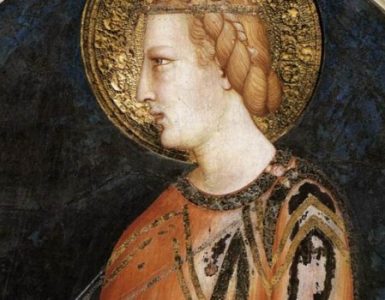Editor’s note: This article is adapted from the book Lord, Teach Us To Pray: A Fulton Sheen Anthology. We also recommend the article “Ten Reasons to Make a Holy Hour According to Fulton J. Sheen.”
“Let nothing hinder thee from praying always, and be not afraid to be justified even to death for the rewards of God continue forever. Before prayer prepare thy soul; and be not as a man that tempt God.”
(Sir. 18:22–23, Douay-Rheims)
Prayer is the lifting of our soul to God unto the end of perfectly corresponding to His holy will. Our Divine Lord, describing His mission, said: “For I have come down from heaven, not to do my own will, but the will of him who sent me . . . the Father, that I should lose nothing of what he has given me, but that I should raise it up on the last day” (see John 6:38–39). “My food is to do the will of him who sent me, to accomplish his work” (see John 4:34).
To correspond to the divine will, we must, first of all, know it, and secondly, have the grace and strength to correspond with it, once it is known. But to attain these two gifts of light for our minds and power for our wills, we must live on terms of intimate friendship with God. This is done through prayer. A prayerful life is, therefore, one lived in conformity with the holy will of God as a prayer less life is a life of self-will and selfishness.
There is an element of prayer common to Jews, Protestants, and Catholics — namely, belief in God. More than half of the prayers, for example, which a priest says in his Divine Office, are taken from the Old Testament. In relation to all three — that is, Jews, Protestants, and Catholics — a Holy Hour will, therefore, be understood as one hour a day spent in meditating on God and our eternal salvation. This Holy Hour can be made anywhere.
For Catholics, however, the Holy Hour has a very special significance. It means a continuous and unbroken hour spent in the presence of Our Divine Lord in the Eucharist; for which reason a meditation on the Blessed Eucharist has been included as one of these meditations in this book.
In the case of priests and religious, it is suggested that they make this Holy Hour in addition to their usual recitation of the Divine Office and Holy Mass.
This Holy Hour will be spent in prayer and meditation. A distinction is here made between the two, with the emphasis on the latter. By prayer, we here understand the recitation of formal prayers, generally composed by a person different from him who prays.
The psalms represent one of the highest forms of vocal prayer and are common to Jews, Protestants, and Catholics. Other vocal prayers include the Our Father, the Hail Mary, the Creed, the Confiteor, Acts of Faith, Hope, and Charity, and thousands of other prayers found in religious books. There are three kinds of attention in vocal prayer: (1) to the words, lest we say them wrong; (2) to their sense and meaning; and (3) to God and the intention for which we pray. The last kind of attention is essential to vocal prayer.
But the principal purpose of these Holy Hour meditations is the cultivation of mental prayer, or meditation. Very few souls ever meditate; they are either frightened by the word or else were never taught its existence. In the human order, a person in love is always conscious of the one loved, lives in the presence of the other, resolves to do the will of the other, and regards as his greatest jealousy being outdone in the least advantage of self-giving. Apply this to a soul in love with God, and you have the rudiments of meditation.
Meditation is, therefore, a kind of communing of spirit with spirit, with God as its object. Without attempting to set down the formal aspects of meditation, but to make it as intelligible as possible to beginners, the technique of meditation is as follows:
1. We speak to God
We begin by putting ourselves in the presence of God. For those who make the Holy Hour before the Blessed Sacrament, there must be a consciousness of our presence before the Body, Blood, Soul, and Divinity of Our Lord and Savior, Jesus Christ. Naturally, there are varying degrees of intimacy with persons. In a theater, there are hundreds present but little or no intimacy between them. The intimacy deepens to the degree that we establish conversation with one or more of them, and according as this conversation springs from a common interest. So it is with God.
Prayer, then, is not a mere asking for things, but an aiming at a transformation; that is, a becoming “conformed to the image of his Son” (Rom. 8:29, KJV). We pray not to dispose God to give us something, but to dispose ourselves to receive something from Him: the fullness of divine life.
2. God speaks to us
Activity is not only on the human side but also on the divine. A conversation is an exchange, not a monologue. As the soul wills to draw near God, God wills to draw near the soul. It would be wrong to monopolize a conversation with friends; it is more wrong to do so in our relations with God. We must not do all the talking; we must also be good listeners. “Speak, Lord, for thy servant heareth” (1 Kings [1 Sam.] 3:9, KJV).
The soul now experiences the truth of the words “Draw near to God, and he will draw near to you” (see James 4:8). All during the meditation, it will conceive devout affections of adoration, petition, sacrifice, and reparation to God, but particularly at the close of the meditation. These affections or colloquies are to be offered preferably in our own words, for every soul must love God in its own way, and God loves each soul in a particular manner.
In the beginning, the soul attracted to Jesus by some impulse of grace, comes to Him, filled with natural thoughts and aspirations, and very ignorant of the supernatural. It understands neither God nor itself. It has a few intimate relations with the Divinity outside of itself and within itself, but it begins to converse with Jesus. If it persists in the frequentation of His company, the Lord gradually takes an ever-increasing share in the conversation and begins to enlighten the soul. In its contemplation of the mysteries of faith, He aids it to penetrate beneath the words and facts and symbols, hitherto known but superficially, and to grasp the inner sense of the supernatural truths contained in these facts or words or symbols. The Scriptures are gradually opened to the soul. The well-known texts begin to acquire a new and deeper meaning. Familiar expressions convey a knowledge, which the soul wonders never to have before discovered in them. All this new light is directed towards giving a fuller and more perfect comprehension of the mysteries of our faith, which are the mysteries of the life of Jesus.
Edward Leen, Progress through Mental Prayer (New York: Sheed and Ward, 1940), 29.
Do not read these meditations as a story. Read a few lines slowly; think about the truth contained in them; apply them to your life; speak to God about how little you have corresponded to His will, how anxious you are to do it; listen to God speaking to your soul; make acts of faith, hope, and love to God; and only when that train of thought has been exhausted should you proceed to the next idea. A single Holy Hour will not necessarily require reading a chapter. If one meditates well, a single chapter should provide thoughts for many Holy Hours.
When these meditations are exhausted, take up either the Sacred Scriptures or some truly spiritual book, or the life of a saint, and use it for inspiration and for meditation.
✠
This article is adapted from the book Lord, Teach Us To Pray: A Fulton Sheen Anthology. It is available from your local Catholic bookstore or online through Sophia Institute Press.
You can learn more about this anthology from its editor, Al Smith, in our podcast interview with him. You can stream our interview below or find Catholic Exchange on your favorite podcast app.













